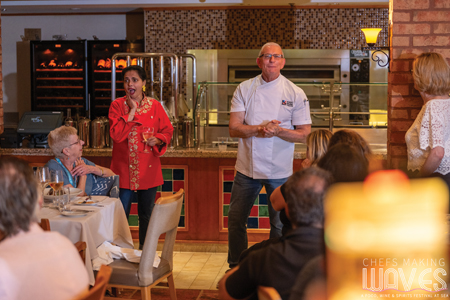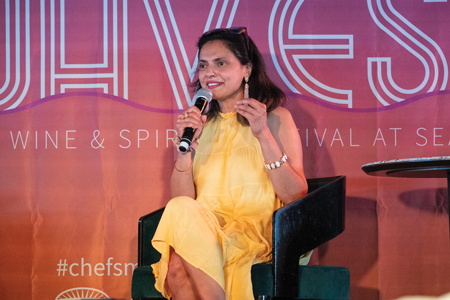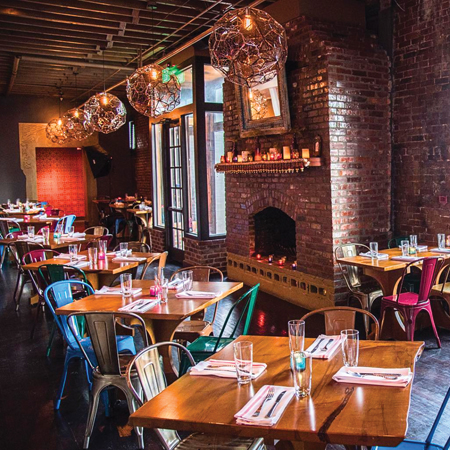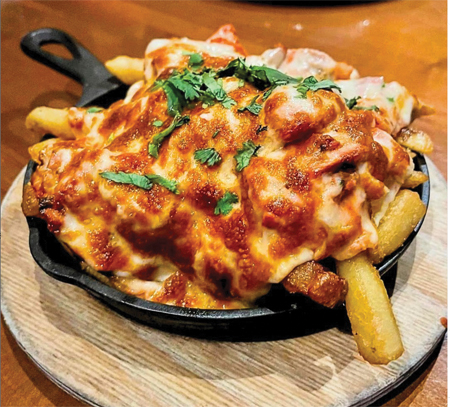Food & Dining: Maneet Chauhan is Making Waves

A fireside chat aboard a cruise ship with the Food Network champion who is taking Indian cuisine mainstream.
I am sailing from Miami to the Bahamas on board the Norwegian Pearl in the first-ever Chefs Making Waves, a four-night all-inclusive culinary cruise showcasing the country’s top celebrity chefs like Andrew Zimmern, Scott Conant, Robert Irvine, and Marcus Samuelsson. The 15 floors of the massive ship are bustling with Food Network fans. There are best friends, mother-daughter duos, neighbors, and couples traveling together to meet the culinary stars they have idolized on television.
The only Indian-American chef onboard is Maneet Chauhan. Originally from Ranchi in Jharkhand, India, Chauhan studied at a hotel management school in Manipal, India, and then at the Culinary Institute of America in New York. A judge on the cooking show Chopped on the Food Network, Chauhan became the first two-time champion of the TV channel’s highest-rated culinary competition series, Tournament of Champions. She recently launched Eet by Maneet Chauhan, the first-ever Indian dining concept in Disney Springs at the Walt Disney World Resort in Orlando, Florida.
the first two-time champion of the TV channel’s highest-rated culinary competition series, Tournament of Champions. She recently launched Eet by Maneet Chauhan, the first-ever Indian dining concept in Disney Springs at the Walt Disney World Resort in Orlando, Florida.
[Right] Maneet Chauhan at a curated chef dinner on the cruise.
(Photo: Tammy Vega / Spectacle Photo)
On board the cruise ship, a petite Chauhan—who sports a loosely fitted yellow sundress, casual sandals, and practically no makeup—is very funny and approachable. She is here to introduce some of her flavors to the guests, interact with fans, and have a holiday with her husband, Vivek Deora, and their two kids. This is her first cruise ever, she tells me.
As Chauhan moves around the cruise activities, from the breakfast buffet and a live podcast to an ’80s disco party, fans surround her, asking for autographs and selfies. She always obliges with a hug and laugh and comes across as a down-to-earth friend you are meeting after a long time.
Eventually, Chauhan and I find a quiet corner at the ship's top deck as we sail through the calm Atlantic Ocean. We continue the conversation well after the four-day cruise.
Where do we stand on the arc of Indian cuisine's mainstream appeal?
 When I came to the U.S. in 1998, Indian food was mostly about greasy, all-you-can-eat, cheap buffets. All Indian restaurants offered the same copycat menus. With the increasing Indian population in the U.S., more Americans traveling, and cookbook authors and television personalities raising awareness of Indian food, people have started recognizing that words like “chai tea” and “naan bread” don’t make sense. It will take time to assimilate, but Indians in the U.S. must take pride and have conversations about the great flavors of Indian food.
When I came to the U.S. in 1998, Indian food was mostly about greasy, all-you-can-eat, cheap buffets. All Indian restaurants offered the same copycat menus. With the increasing Indian population in the U.S., more Americans traveling, and cookbook authors and television personalities raising awareness of Indian food, people have started recognizing that words like “chai tea” and “naan bread” don’t make sense. It will take time to assimilate, but Indians in the U.S. must take pride and have conversations about the great flavors of Indian food.
[Left] Speaking at a live blog talk show on the cruise. (Photo: Amy Harris / The Travel Addict)
Would such popularity come at the price of sacrificing traditional authenticity?
Food in India has had historic confluences from across the world. Kebabs came from Persia. Tomatoes and potatoes came from somewhere else. Tikka masala originated in our lifetimes from the UK. “Authentic” is your own story and is open to interpretation. The daal you make is slightly different from what I make. Some first-generation Indian diners come to my restaurant and say, “This is not how my mom made it; this is not authentic.” But each state in India has its own signature on the food, so where do you start the argument? People who have grown up in India understand our vast food diversity and global influences, such as Chinese in Tangra (in Kolkata), French in Pondicherry, and Portuguese in Goa. At my restaurant, I make garam masala-rubbed ribeye, ghee-poached lobster pav, and tandoor chicken poutine with cheese curds and makhani sauce. It is not authentic French, Indian, or British; it is authentic Maneet!
 For the cruise passengers, I created a naanzella salad inspired by papri chaat from the streets of India, combined with the inspiration I got during my travels to Italy. Authentic is bringing your own flavors to the forefront. I love to have fun with food and show who I am through my food.
For the cruise passengers, I created a naanzella salad inspired by papri chaat from the streets of India, combined with the inspiration I got during my travels to Italy. Authentic is bringing your own flavors to the forefront. I love to have fun with food and show who I am through my food.
[Right] Eet by Maneet Chauhan, the first-ever Indian dining concept in Disney Springs at the Walt Disney World Resort in Orlando, Florida.
How do you handle criticism and naysayers?
Some chefs get triggered by criticism; but with age, I have learned to tackle it with more humor than anything else. I get into light-hearted conversations with guests about specifics—for example, why do some people put mustard seeds in daal, and does that make it more authentic?
You have to have a thick skin on social media and not let things affect you. But sometimes, you receive 300 messages telling you how great you are and one will say, “She walked by me and did not speak to me; she’s not very nice.” Our human nature is that we obsess over that one hateful post. Over the years, I have trained myself to manage the negative comments. Instead, I live with an attitude of gratitude. I am grateful for the opportunity to be on this ship with all these great chefs!
Are you expected to represent Indian food on television?
Sometimes, my viewers say that I should be cooking authentic Indian food. I cook what is authentic to me, incorporating what has influenced me—which is a blend of cultures. On the show Chopped, I was talking about the four to five different ways I make karela (bitter gourd), and someone said, “I am sorry for you that you peel it!”
How would Indian cuisine fit into the growing trend of health-conscious dining?
Like in any cuisine, some dishes are rich, and others are well-balanced and healthy. The food I grew up on was always seasonal. The spices we use have health benefits. And home cooking is not overly greasy. Indian food is sattvic—it puts your body in balance. The foundation of Indian cuisine is very healthy, but what is served in restaurants is indulgent. Eating out is supposed to be for special occasions and in moderation. When you go to an Indian restaurant, you can choose to eat grilled meats and gluten-free cauliflower rice and avoid fried foods. We are already seeing so many fast-casual Indian restaurants offering enhanced salads and build-your-own bowls that are quite healthy.
 Are you diluting Indian flavors by making them fusion?
Are you diluting Indian flavors by making them fusion?
We cannot expect all Americans to adopt Indian food overnight. I want to bring about change, one person at a time. But if we give up and say it’s all or nothing, then we won’t have any movement at all. There’s an audience that has not tried Indian food before, so I want to give them an opportunity to try it by sneaking in those flavors—for example, eating comforting chicken tenders with spicy tikka sauce. At Chauhan Ale & Masala House, we give kids small bowls so they can at least try the Indian dishes. Sometimes, the parents may order chicken tikka and let the picky eaters nibble on it.
[Left] Tandoori chicken poutine with cheese curds and makhani sauce.
At Eet in Disney Springs, we are required to offer kid-friendly menu items, including sliders and chicken fingers. So, I have to package things so they are more approachable. Kids love trying the bread service with pimento whipped paneer, chocolate and strawberry naan, and gulab jamun cheesecake.
Sucheta Rawal is an award-winning food and travel writer who has traveled to over 100 countries across seven continents, experiencing the world through her palate. She has been named one of the most influential cultural bloggers in the world for her blog Go Eat Give. Find her on social @SuchetaRawal.
Enjoyed reading Khabar magazine? Subscribe to Khabar and get a full digital copy of this Indian-American community magazine.
blog comments powered by Disqus










